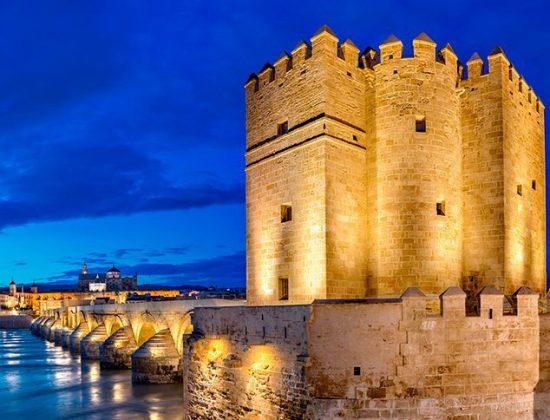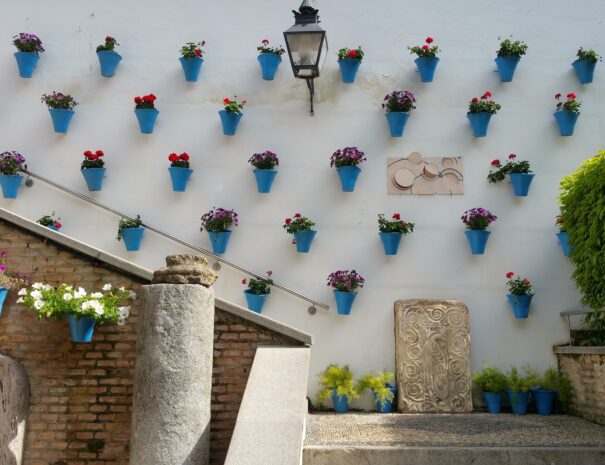
Roman bridge and Calahorra tower – Córdoba
The Roman Bridge and Calahorra Tower are two gorgeous historical sites that are a must while in Córdoba, here you will find all the info you need. … Read More
The mosque is not only a pastoral symbol for worshippers but is also a witness of thousands of years of fascinating history.
The Great Córdoba Mosque is a grandiose and fascinating part of Muslim art, initiated by the Caliph Abderraman I, that resumes in its history the evolution of the Omeya style in Spain on top of the Gothic, Renaissance and Baroque style of the Christian construction, This is one of Spain´s landmarks, a must-visit, unique place in the world.
The Mosque can be visited every day. We strongly recommend booking well ahead and avoiding, above all, purchasing your entrance tickets on the date you plan to visit. This is possible, but not only is there the risk no places are left but also you will for sure spend a good amount of time queuing. Guided tours or private tours are a good option to visit. There are many! We recommend you a few to ease the process.
With these tours you avoid queues and you will be accompanied by local experts. They are all very highly rated
The Great Córdoba Mosque is a grandiose and fascinating part of Muslim art, initiated by the Caliph Abderraman I, that resumes in its history the evolution of the Omeya style in Spain on top of the Gothic, Renaissance and Baroque style of the Christian construction, This is one of Spain´s landmarks, a must-visit, unique place in the world and for many people Spain´s most beautiful cathedral as well.
The Cordoba Mosque was named a UNESCO World heritage building in 1984.
This world-famous building is also known as the Mezquita, was the principal mosque of western Islam and is the largest and most beautiful mosque of all.
It was begun in 785 (under the rule of the first Emir of Córdoba Abd ar Rahman (756-88), on the foundations of a Roman temple of Janus and a Visigoth church. Along with the Alhambra in Granada, these are Spain´s most important attractions that date back to the times of the Morrish occupation.
The mosque originally had 11 aisles but, by the end of the 10C, after various extensions, there were 19 aisles and it was 600 ft. long and 430 ft. wide-including the Patio de los Naranjos, the Courtyard of Orange Trees. The mosque became a Christian church in 1236 after the conquest of Córdoba.
Since it the X century, it was the San Vicente Basilica. After the “Reconquista”, the Christians put their “Gothic Cathedral” in the heart of the transept
The Cathedral was built in the XVI century after Carlos V authorized the construction in the inside of the Mosque, respecting the extension of Alhaken II starting with two centuries of architectural evolution with a Latin-cross layout with Gothic vault, baroque and renaissance dome.
Emperor Charles V then set about the insertion of a larger church, which is, nevertheless, dwarfed by the Arab mosque. This intrusion, later-but too late-regretted by the Emperor was halted in 1599. The whole complex is surrounded by a battlemented and buttressed fortress-like wall, broken by several gates.
Since it the X century, it was the San Vicente Basilica. After the “Reconquista”, the Christians put their “Gothic Cathedral” in the heart of the transept

The Mosque of Cordoba has two distinct areas: the patio/portico where the minaret is (under the Renaissance tower), which was Abd al-Rahman III’s only invention, and the prayer room/haram.
The inside of this Mosque kept the first Islamic influence, inspired by the Mosque of Damascus and combines Roman Hispanic art, overlapping arches alternating with red bricks and stones, and materials used by artists with beautiful Byzantine mosaics.
Unlike any monument in the world, you can find a peculiar detail in every area of the mosque-cathedral with each door named. Due to the various cultures that have shaped it over the centuries from the Middle Ages to today, it is definitely unique and special place.
The Patio de los Naranjos with its palms and orange trees forms the extension on the Northern side of the mosque; formerly this had been open, but it was walled after the conquest of the town. On the courtyard walls, there are remnants of beams, and these give some impression of the mosque’s old, carved ceiling.
There is something special when crossing the courtyard with all its aromas and orange trees, where great philosophers have taught their classes.
The interior space is disposed on an assembly of columns and bicolor arcades of great chromatic effect. There are five areas in which the building is divided, each corresponding to different extensions.
The prayer hall is relatively low (only 38.5 ft. high) and there is an overwhelming impression of a ‘forest of columns’ (c. 850). These form 19 transepts and 36 aisles, without giving the impression of any particular alignment usually so apparent in Christian churches.
The columns of marble, jasper or granite have Javish and varied capital decorations (in the main they came from Roman and Visigoth buildings). Resting upon the columns and crossing over each other, are round and horseshoe arches; these are rendered particularly attractive by the alternate use of red and white marble–an effect not originally intended in the mosque.
Arches from a later date in the S. and E. of the mosque have preserved their particularly rich, somewhat fan-like arrangement. There are elegant columns between the upper rows of arcades and extraordinarily lavish ornamentation on the intrados and on other surfaces of the arches.
The wider aisle leads from the Puerta de las Palmas (originally the central aisle of the 11-aisled building) to the Capilla Villaviciosa. This was formerly the second Mihrâb (the extension under Abd er Rahman II, mid 9C), and it has architecturally interesting ribbed vaulting, which was only found in Christian churches 200 years later.
The current tower covers the minaret crowned by a statue of the San Rafael Archangel Guardian of Cordoba. This tower is attached to the Forgiveness Gate – the main entrance to the site.
The Cathedral consists of the Capilla Mayor (this will be covered later), the transept, and choir. Construction started under Hernán Ruiz the Elder (1523-39), was continued by Hernán Ruiz the Younger and El Moro, and was only completed in 1599.
The Christian insertion unites the Gothic emphasis on height with the Renaissance arrangement of the walls. Further details include a red marble altar; two interesting baroque pulpits (1760); and the excellent Churrigueresque-baroque choir stalls in mahogany, with scenes from the Old and New Testament, by Pedro Duque Cornejo.
The choir is covered by a dome inspired by the Sixteenth Chapel, in which the choir chairs stand out – made out of mahogany with different themes craved and sculpted into them.
The Capilla Real dates from the 14C, and it was the burial chapel of the Castilian Kings Ferdinand IV and Alfonso XI. The beautiful Mudéjar stucco, as well as the faîence, exemplify the art of Granada.
On the Southern wall of the 10C addition (under Al-Hakam II) is the splendid Mihrâb (Nuevo), which dates from the time of the most dazzling development in Harambe ab art. Originally the Mihrâb was just a small niche marking the direction of Mecca for worshippers; now this room’s splendour encapsulates Córdoba’s fame.
The gloriously colorful mosaic decoration of the octagonally-domed Kebla, which precedes the Mihrâb, also exemplifies the superb original artistic skill.
Puerta de las Palmas. Upon returning into the Cordoba Mosque through the Palmas door, the natural lighting and colors are spectacular; a forest of 850 granite columns, marble and jasper with red and white arches. This sea of beautiful columns with the lighting makes the sights spectacular.
The sole surviving Arab gate, the Puerta de San Esteban (8C) is on the West side. On the east side there is the Puerta de Santa Catalina (Renaissance), which has reliefs of the old minarets. The Puerta del Perdón (Gate of Mercy) , on the northern side, became the main entrance to the mosque due to its importance with ceremonies linked to the Cathedral. Next to the ‘Gate of Mercy’ there is a balustraded Renaissance bell tour of six storeys.
The construction of the Great Mosque was begun in 785 (under the rule of the first Emir of Córdoba Abd ar Rahman (756-88), on the foundations of a Roman temple of Janus and a Visigoth church.
Emperor Charles V then set about the insertion of a larger church, which is, nevertheless, dwarfed by the Arab mosque. This intrusion, later-but too late-regretted by the Emperor was halted in 1599. The whole complex is surrounded by a battlemented and buttressed fortress-like wall, broken by several gates.
The mosque originally had 11 aisles but, by the end of the 10C, after various extensions, there were 19 aisles and it was 600 ft. long and 430 ft. wide-including the Patio de los Naranjos, the Courtyard of Orange Trees. The mosque became a Christian church in 1236 after the conquest of Córdoba.

The Roman Bridge and Calahorra Tower are two gorgeous historical sites that are a must while in Córdoba, here you will find all the info you need. … Read More

A complete visitors guide to the Palacio de Viana in Córdoba. The Palacio de Viana is one of the essential monuments to visit in the city. … Read More

Guide to visit the world-famous Patios De Córdoba which is one of the essential stops when visiting this magical city in Southern Spain. … Read More

Guide to visit the Alcazar de los Reyes Cristianos in the magical city of Córdoba, one of the must-see attractions if you are visiting the city. … Read More
is proudly powered by WordPress